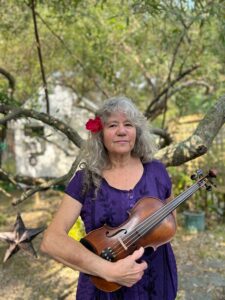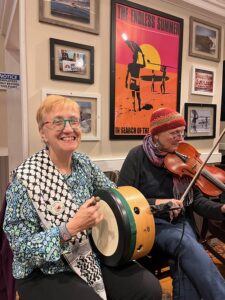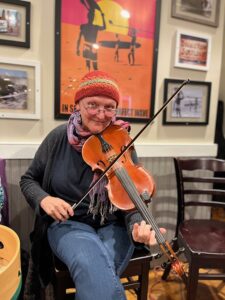The crowd is smaller than usual tonight, I’m told. Most weeks, twice as many people are eating and drinking and talking over the musicians playing in the corner near the kitchen, of which tonight I am one.
Someone’s on the bodhrán, an Irish frame drum. Someone’s playing the bones. There’s a regular-looking guitar and one that looks famished — it’s a “backpacker” model, light and portable, its sides shaved away. My sister, Eve, is on the cello. She’s chopping a beat with her bow. I’m on the fiddle, same as Andrea Pluhar and Denya LeVine.
A couple of microphones are pointed at the players, pulled closer by those confident on a tune, and pushed sheepishly away by the shy. I’m one of the shy, a classical violinist with a violin attempting to metamorphose into a fiddler with a fiddle. These sessions happened at the Fox & Crow in Wellfleet for the last couple of years; now they’re Tuesday evening jams at Hog Island on Route 6.

LeVine completed her metamorphosis years ago — as a child, she played classical violin. She set her instrument down for 15 years, and when she picked it back up at age 30, she wanted to fiddle. She was living in Cambridge at the time and played in a band called the City Ladies Country Quartet, gigging and performing on the street.
When LeVine moved to Wellfleet in 1980, she says, she was one of only two people who played traditional music. Now the number of traditional musicians in Wellfleet is around 20. They play Celtic, Irish, Scottish, old-time Appalachian, and folk music.
When a violin becomes a fiddle, the change is wholly conceptual. The real change occurs in the player. As a violinist becomes a fiddle-player, the bow is held more loosely; the wrist flicks to play juddering triplets. The fingers of the left hand slide and flutter in turns. The fiddle can rest against the chest or under the chin, whichever the player prefers. Relax in the chair and it’ll sound better is the idea.
Traditional tunes are learned by ear. They repeat in varying patterns until the players decide to move on — a kick of the leg signals the last repetition of a tune. Another tune will follow, often without pause.
LeVine organizes the sessions here. Musicians can drop in, but LeVine wants them to email her beforehand because one night 17 people showed up for a session. The musicians’ corner at Hog Island is barely large enough for eight. My elbow is jabbing the side of the fiddler beside me. Somebody’s shoe grazes the hair of my bow when I lower it for a break.

The musicians also have other kinds of get-togethers. “For about 12 or 13 years, we’ve had a big campfire-potluck-music jam once a summer,” says LeVine. During the rest of the year, the players get together at someone’s house for food and music — they all enjoy both. “But if we had to choose between food and playing music, we’d play music,” she says.
Aylette Jenness sometimes hosts those off-season sessions at her house off Cove Road. The house was bought by her parents in the 1920s. Jenness doesn’t play an instrument. “I bill myself as an avid listener,” she says. “And listening to live music is very different from listening to a record.”
Jenness is 90 years old and losing her vision. She lives alone except for her cat, Purrsia. She loves traditional music because “it’s real music from the heart,” she says. She appreciates the warmth of the musicians that “every once in a while” crowd her house.
It’s been a week, and I’m back at Hog Island, sweating on my violin — fiddle. It’s warm in here, in more ways than one. Pluhar and LeVine are going through the motions of an Irish polka, rollicking and repetitive. LeVine encourages the audience to dance. “There’s plenty of space,” she says, leaning into the microphone.

I’m staring at Pluhar’s fingers as they frolic over the A and D strings, leap for a moment onto the E string, then tumble down again. I’ve never heard this tune before; I’m playing everything wrong. There! I catch Pluhar on the E string. She glances over, gives me a smile.
I’ve come prepared with a couple of tunes I’ve been learning on my own: a jig called “The Burnt Old Man” and another, slower tune called “Still Together.” My technique is still so undeveloped, but I pretend; like a teenager attempting to sound like an adult when she speaks, I move my bow in ill-advised ways and flicker my fingers in awkward-sounding turns and trills.
Afterward, I tell Pluhar I was faking it. “Well,” she says, “you’ll fake it even better next week.” Someday, I think, I might even make it.
Cheryl Parkington is here with her husband, Mike Murzyn. Parkington’s on guitar and vocals, and Murzyn’s playing the upright bass. When she was younger, says Parkington, “I wasn’t a hippie. I was a folkie. There’s a difference.”
Parkington and Murzyn play in more than one traditional music group. Parkington remembers a night recently when she felt too tired to go out and play. “But then I thought, every time I go, the music makes me feel so much better, and I’m not tired anymore,” she says.
Parkington thinks a lot about the necessity of community. At a session at Hog Island a month ago, she watched a mother and son stand up from the audience to sing a song together. “The music draws people out,” she says, “and it brings them together.”
An hour later, I pack my instrument up to leave. The other players will keep going for another hour. They wave goodbye and start up the next tune.
LeVine became a full-time gigging musician in 2022. She plays a lot for preschool children and at day-centers for adults with developmental disabilities. “My favorite thing to do,” she says, “is to go into a room that is very quiet and to create joy and energy.”
A lot of the people at the day-centers are nonverbal, says LeVine. “That doesn’t mean they can’t make sound — they just don’t have language.” Often, when she comes for a gig, she’ll bring rhythm instruments and people play along.
LeVine used to gig only part-time. But, she says, “You’ll understand — when it’s so strong in you, you want to do it all the time.”



